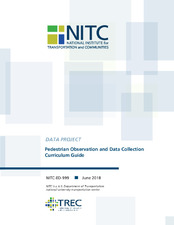| dc.creator | Goddard, Tara | |
| dc.creator | Dill, Jennifer | |
| dc.date.accessioned | 2020-02-09T17:08:55Z | |
| dc.date.available | 2020-02-09T17:08:55Z | |
| dc.date.issued | 2018 | |
| dc.identifier.citation | Dill, Jennifer and Tara Goddard. Pedestrian Observation and Data Collection Curriculum Guide.(2018) NITC-ED-999. Portland, OR: Transportation Research and Education Center (TREC), 2018. https://dx.doi.org/10.15760/trec.195 | en |
| dc.identifier.uri | https://hdl.handle.net/1969.1/187113 | |
| dc.description | This is a final report, NITC-ED-999, from the NITC program of TREC at Portland State University, and can be found online at: https://nitc.trec.pdx.edu/research/project/999
The project brief associated with this research can be found at: https://archives.pdx.edu/ds/psu/25833 | en |
| dc.description.abstract | This guidebook provides a comprehensive set of class exercises suitable for students in courses related to travel behavior, traffic safety, urban planning and design, community health, or civil engineering. Exercises include activities developed through this project as well as an extensive set of educational materials drawn from online resources. The exercises developed as part of this project focus on pedestrians. They include elements of both traditional traffic counts and behavioral components, the latter of which are often lacking from current data collections efforts. By encouraging students to consider behavioral interactions of roadway users, these exercises can provide students with field experience that collects data that underlie behavioral traffic theory and agent-based traffic models. The materials are organized to provide helpful guidance to instructors and provide insights gathered through the pilot testing of classroom materials. Activities drawn from existing resources provide a comprehensive set of educational materials that address different facets of pedestrian and bicycle planning. The educational curricula and resources outlined in this guide allow instructors with little or no experience to integrate pedestrian-related curriculum into their teaching. The guide may also prove useful for organizations interested in pedestrian and bicycle planning and provide additional resources for experienced instructors. Included curricula are aimed at undergraduate or graduate university students, but can be easily adaptable to high school students or community college classes interested in exploring these issues.
Specific outcomes include the following:
• Readings, curriculum, data collections tools, and general research design that instructors can adapt to their needs, while standardizing the data collection method. This can enrich classroom learning and facilitate fieldwork experience.
• The data collected from the exercise may provide a benefit to local agencies. Local jurisdictions are often interested in partnering with local university classes on data collection, but time constraints, particularly in the quarter system, can make planning and execution of projects time-prohibitive. | en |
| dc.description.sponsorship | This project was funded by the National Institute for Transportation and Communities (NITC) under grant number 999. Additional resources in the guide are public documents courtesy of the Federal Highway Administration (FHWA), the Pedestrian & Bicycle Information Center (PBIC), the Initiative for Bicycle and Pedestrian Innovation (IBPI), Ryan Snyder at the UCLA Department of Urban Planning, and Krista Nordback of the University of North Carolina Highway Safety Research Center (UNC-HSRC). | en |
| dc.language.iso | en_US | |
| dc.publisher | Transportation Research and Education Center | |
| dc.relation.ispartofseries | ;NITC-ED-999 | |
| dc.rights | Attribution-NonCommercial-NoDerivs 3.0 United States | en |
| dc.rights.uri | http://creativecommons.org/licenses/by-nc-nd/3.0/us/ | |
| dc.subject | transportation planning; pedestrian; data collection; curriculum; observation; field experiment | en |
| dc.title | Pedestrian Observation and Data Collection Curriculum Guide | en |
| dc.type | Learning Object | en |
| dc.type | Technical Report | en |
| dc.identifier.doi | 10.15760/trec.195 | |



